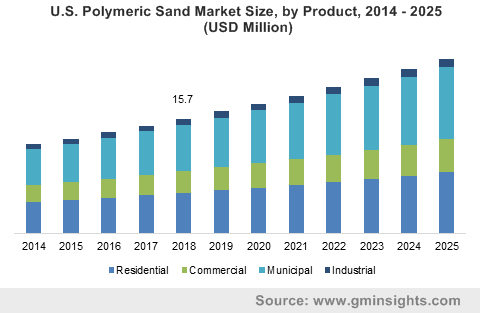Europe polymeric sand market to register substantial gains over 2019-2025, application in parking spaces to boost the product demand
Publisher : Fractovia | Published Date : 2019-05-10Request Sample
Rising infrastructure investment by public as well as private sectors will provide a considerable thrust to the global polymeric sand market, owing to a broad application scope in commercial, residential and municipal projects. Apparently, polymeric sand comprises a unique mixture of fine sands and certain other polymers that form a remarkable strong binding agent when mixed with water to lock the particles of sand together. The material is suitable as joint filler between stone, brick and concrete pavers, which are widely utilized in building pavements, patios, pool decks and parking lots. As increasing number of residential complex, industrial parks and commercial spaces are built, the polymeric sand industry will garner mammoth revenues over the forecast timespan.
U.S. Polymeric Sand Market Size, by Product, 2014 – 2025 (USD Million)

Prime benefits that make polymeric sand preferable over just asphalt or concrete pavers include enhanced durability and strength for a longer period of time, resistant to creatures like ants and availability in numerous colors as required. However, a notable advantage of the substance is that it deters the growth of weeds, which are a common nuisance in patios, parking spaces and pavements. It is more resilient against weed as compared to plain sand and this characteristic has immensely boosted demand for the polymeric sand market in recent years. Another issue with common sand is that joints are easily washed away in heavy storm or rain, whereas polymeric sand joints minimize the quantity of water washing between the pavers and keep the base foundation intact and more reliable.
Understandably, consistent spending by governments on public welfare, roads, highways and housing amenities will ensure a ready target base for the polymeric sand industry, particularly in the construction of pavements and auxiliary spaces which are the responsibility of municipalities. Germany, for instance, has allocated nearly US$170 billion for infrastructure, housing, education and digital technologies for the next four years. A sizable portion of these funds can be expected to be used for repair or maintenance of pavements and other public access areas, even at airports, railway stations and open parking spots, creating significant opportunities for the Europe polymeric sand market.
Enumerating growth prospects for the Europe polymeric sand market with respect to application in parking spaces:
Reports claim that the U.S. has more than 2 billion parking spots for about 250 million cars, indicating the efforts made by governments, private firms and individuals to offer more than ample car parks needed by the growing population. Europe also faces demand for sufficient spots due to the presence of hundreds of government buildings, malls, schools and expansive housing schemes. Home to major global auto makers, Europe had recorded sale of over 17.9 million passenger cars in 2017, affirming the huge number of vehicles on road and in need of parking spaces at different locations visited by car owners.
Polymeric sand, when used in laying out parking spaces, can help to address problems like durability, plant growth and over reliance on drainage, as the impermeable nature of concrete and asphalt often requires separate drainage systems. It is also simpler to finish, saves money and time and has long-term financial benefits. The polymeric sand industry is gradually experiencing demand from parking space constructors worldwide, and Europe could likely represent one of the promising regional markets.
To infer the industry potential, consider the largest mall in the U.K., Trafford Center in Manchester, which has a footfall of nearly 35 million every year. A facility of this size will warrant massive parking spaces to be built in and around the mall to accommodate thousands of daily visitors, a major chuck of which could be traversing in their vehicles. Continuous increase in the use of vehicles in Europe has also prompted the emergence of various services that build and manage car parks, for example, Ile-de-France region’s second biggest parking operator, Saemes, which manages around 90 car parks.
In a nutshell, parking spaces form a critical part of any nations infrastructural progress and the development or upgradation of car parks could substantially augment consumption for the polymeric sand market. Alliance Designer Products Inc., Techniseal, Fairmount Santrol, Sakrete Inc., SEK Surebond Inc. and Silpro are some of the leading participants in the polymeric sand industry.